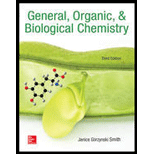
(a)
Interpretation:
The element with higher ionization energy from bromine and iodine should be determined.
Concept Introduction:
An atom is composed of three main sub-atomic particles; electrons, neutrons and protons. The
The long form of periodic table shows a periodic relation between different properties of elements such as ionization energy,
Ionization energy is the energy that is required to remove an electron from the valence shell of the neutral gaseous atom.
(b)
Interpretation:
The element with higher ionization energy from carbon and nitrogen should be determined.
Concept Introduction:
An atom is composed of three main sub-atomic particles; electrons, neutrons and protons. The atomic number of the elements represents the number of protons or electrons in a neutral atom. All known elements are arranged in a tabular form in increasing order of their atomic number which is known as the periodic table.
The long form of periodic table shows a periodic relation between different properties of elements such as ionization energy, electron affinity, atomic radii, etc.
Ionization energy is the energy that is required to remove an electron from the valence shell of the neutral gaseous atom.
(c)
Interpretation:
The element with higher ionization energy from silicon and potassium should be determined.
Concept Introduction:
An atom is composed of three main sub-atomic particles; electrons, neutrons and protons. The atomic number of the elements represents the number of protons or electrons in a neutral atom. All known elements are arranged in a tabular form in increasing order of their atomic number which is known as the periodic table.
The long form of periodic table shows a periodic relation between different properties of elements such as ionization energy, electron affinity, atomic radii, etc.
Ionization energy is the energy that is required to remove an electron from the valence shell of the neutral gaseous atom.
(d)
Interpretation:
The element with higher ionization energy from Chlorine and selenium should be determined.
Concept Introduction:
An atom is composed of three main sub-atomic particles; electrons, neutrons and protons. The atomic number of the elements represents the number of protons or electrons in a neutral atom. All known elements are arranged in a tabular form in increasing order of their atomic number which is known as the periodic table.
The long form of periodic table shows a periodic relation between different properties of elements such as ionization energy, electron affinity, atomic radii, etc.
Ionization energy is the energy that is required to remove an electron from the valence shell of the neutral gaseous atom.
Want to see the full answer?
Check out a sample textbook solution
Chapter 2 Solutions
EBK GENERAL, ORGANIC, & BIOLOGICAL CHEM
- Lab Data The distance entered is out of the expected range. Check your calculations and conversion factors. Verify your distance. Will the gas cloud be closer to the cotton ball with HCI or NH3? Did you report your data to the correct number of significant figures? - X Experimental Set-up HCI-NH3 NH3-HCI Longer Tube Time elapsed (min) 5 (exact) 5 (exact) Distance between cotton balls (cm) 24.30 24.40 Distance to cloud (cm) 9.70 14.16 Distance traveled by HCI (cm) 9.70 9.80 Distance traveled by NH3 (cm) 14.60 14.50 Diffusion rate of HCI (cm/hr) 116 118 Diffusion rate of NH3 (cm/hr) 175.2 175.2 How to measure distance and calculate ratearrow_forwardFor the titration of a divalent metal ion (M2+) with EDTA, the stoichiometry of the reaction is typically: 1:1 (one mole of EDTA per mole of metal ion) 2:1 (two moles of EDTA per mole of metal ion) 1:2 (one mole of EDTA per two moles of metal ion) None of the abovearrow_forwardPlease help me solve this reaction.arrow_forward
- Indicate the products obtained by mixing 2,2-dimethylpropanal with acetaldehyde and sodium ethoxide in ethanol.arrow_forwardSynthesize 2-Ethyl-3-methyloxirane from dimethyl(propyl)sulfonium iodide using the necessary organic or inorganic reagents. Draw the structures of the compounds.arrow_forwardSynthesize 2-Hydroxy-2-phenylacetonitrile from phenylmethanol using the necessary organic or inorganic reagents. Draw the structures of the compounds.arrow_forward
- Synthesize N-Methylcyclohexylamine from cyclohexanol using the necessary organic or inorganic reagents. Draw the structures of the compounds.arrow_forwardSynthesize N-Methylcyclohexylamine from cyclohexanol using the necessary organic or inorganic reagents. Draw the structures of the compounds.arrow_forwardIf possible, please provide the formula of the compound 3,3-dimethylbut-2-enal.arrow_forward
- Synthesize 1,4-dibromobenzene from acetanilide (N-phenylacetamide) using the necessary organic or inorganic reagents. Draw the structures of the compounds.arrow_forwardIndicate the products obtained by mixing (3-oxo-3-phenylpropyl)triphenylphosphonium bromide with sodium hydride.arrow_forwardWe mix N-ethyl-2-hexanamine with excess methyl iodide and followed by heating with aqueous Ag2O. Indicate the major products obtained.arrow_forward
 Introductory Chemistry: A FoundationChemistryISBN:9781337399425Author:Steven S. Zumdahl, Donald J. DeCostePublisher:Cengage Learning
Introductory Chemistry: A FoundationChemistryISBN:9781337399425Author:Steven S. Zumdahl, Donald J. DeCostePublisher:Cengage Learning General, Organic, and Biological ChemistryChemistryISBN:9781285853918Author:H. Stephen StokerPublisher:Cengage LearningChemistry: Matter and ChangeChemistryISBN:9780078746376Author:Dinah Zike, Laurel Dingrando, Nicholas Hainen, Cheryl WistromPublisher:Glencoe/McGraw-Hill School Pub Co
General, Organic, and Biological ChemistryChemistryISBN:9781285853918Author:H. Stephen StokerPublisher:Cengage LearningChemistry: Matter and ChangeChemistryISBN:9780078746376Author:Dinah Zike, Laurel Dingrando, Nicholas Hainen, Cheryl WistromPublisher:Glencoe/McGraw-Hill School Pub Co Introduction to General, Organic and BiochemistryChemistryISBN:9781285869759Author:Frederick A. Bettelheim, William H. Brown, Mary K. Campbell, Shawn O. Farrell, Omar TorresPublisher:Cengage Learning
Introduction to General, Organic and BiochemistryChemistryISBN:9781285869759Author:Frederick A. Bettelheim, William H. Brown, Mary K. Campbell, Shawn O. Farrell, Omar TorresPublisher:Cengage Learning





